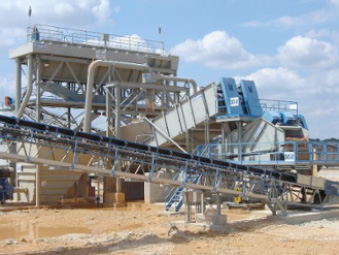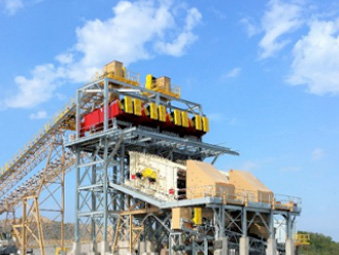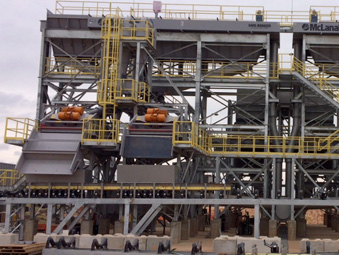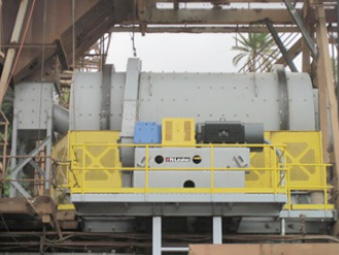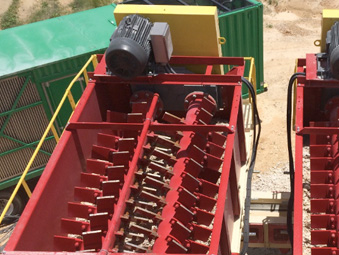A Look at Traditional Solutions Washing & Classifying Equipment and How to Select the Right Equipment for Your Site
With all the different options, manufacturers and types of equipment, selecting equipment for washing and classifying can seem like a daunting task. The most important thing to understand and note is that processing requirements can vary from site to site because raw materials may have differing properties that need differing solutions. A one-size-fits-all solution is rarely right for your site. When selecting equipment, you need to take these many types of process options into consideration and base your purchase on the solution that will provide you efficiency and a quick return on your investment. The best thing to do is to talk to a process engineer that understands the needs of your deposit, as well as all of the available equipment options to help you make the right solution. The following is a guide on the types of wet processing equipment available in the market. It will focus on what we are going to call “classic” washing and classifying equipment, which includes:
This equipment helps producers more efficiently process raw materials into sellable products This guide is designed to help you get a basic understanding of the different washing and classifying equipment you can use at your site, and hopefully help you make the right decision when talking to various equipment manufacturers about available solutions for your site. Remember, there are lots of solutions out there today – pick the one that meets your processing goals, while giving you the ROI you need to make your site profitable. Aggregate Conditioners
Aggregate Conditioners, also referred to as Blade Mills, use a combination of paddles and flights arranged in an alternating format along the length of the shaft to scour, abrade and breakdown water-soluble silts and deleterious clays from a coarse rock or sand feed. They can be placed ahead of a wash screen or other washing equipment, such a classifying tank or fine material screw washers. Aggregate conditioners are not the solution to remove tough, plastic clays, but are recommended when water soluble clays or crusher dust contaminants needs to be worked or wetted before further processing, resulting in cleaner rock and or sand. Although similar in appearance to coarse material screw washers, aggregate conditioners function very differently. All material and water entering the aggregate conditioner must exit through the discharge opening at the bottom of the box opposite the feed end. There is no weir overflow of water and liberated silts and clays. Aggregate conditioners are typically installed on a slope of zero to five degrees, providing higher capacities. Using a combination of spiral screw flights and paddles on the conditioner’s shafts helps keep operation and maintenance simple. A 360-degree screw flight equipped with inner and outer wearing shoes located in the initial feed end moves material forward into an area of scrubbing paddles and additional intermittent screw flights. Screw shafts made of extra-heavy steel pipe with inner and outer renewable, reversible abrasion-resistant hard iron paddles provide high wear life. Reversing some of the paddles will keep material in the box longer increasing retention and scrubbing time. If the operator chooses to move the unit or feed it larger amounts of deleterious material, it is still usable despite many changing conditions. It is recommended that you have V-belt drive guards for personnel safety. You can also look at the availability of optional discharge chutes and top covers for personnel protection. Classifying Tanks
Classifying tanks process minus 4mesh or 5mm sand where construction sand specification grades are to be produced. Sites would select a classifying tank for one or more of the following reasons: 1. Removing excess water With either slurry or a dry feed, they are capable of handling sand gradation swings in the sand deposits, while minimizing production of non-specification sands. Sand classification in a classifying tank is based on the different settling rates of various sand grain sizes. As water and material enter the feed end, coarser, heavier particles settle first with finer grains settling in successive sizes along the length of the tank. At the top of the tank, a series of hydraulic control mechanisms operate the discharge valves at the bottom of the tank. Depending on the type of control system and products produced, two or three discharge valves are located at each station. When the discharge valves open, sand is directed to a two or three-way divided collecting flume and then to the associated dewatering equipment. Optional rising current classification systems are recommended for fresh water injection aids in the sand classifying process. Protective personnel top covers, supporting structures and service walkways are also from classifying tank manufacturers. Coarse Material Screw Washers
Used to wash crushed stone and gravel, coarse material screw washers effectively remove light, loamy clays, dirt, crusher dust and coatings that cannot be removed by wet screening alone. They can also be used to remove non-water-logged, floating vegetation and soft aggregate out of harder material feed. The slope or incline of installation can vary from 12 to 18 degrees, allowing a slurry overflow of wash water and liberated contaminants. The number of paddles varies depending on the severity of the washing needed and capacity requirements. Coarse material screw washer paddles provide scrubbing, scouring and agitation, which are used in conjunction with screw flights. The turbulent paddle washing action combined with rising current water introduced at the feed-end at the bottom of the washer box, results in separation of lighter fractions from the sound aggregate. Lighter fractions float to the surface due to water rising current and then overflow a weir located at the back of the box. Desired clean product is conveyed by the spiral flights to the discharge end of the machine. The combination of spiral screw flights and paddles keeps operation and maintenance simple. A 360-degree screw flight equipped with inner and outer wearing shoes located in the feed end moves material forward into the scrubbing paddle section. Screw shafts made of extra-heavy steel pipe with inner and outer renewable, reversible abrasion-resistant hard iron paddles provide high wear life. Reversing some of the paddles can help keep material in the box longer, increasing retention and scrubbing time. If the operator chooses to move the unit or feed it larger amounts of deleterious material, it is still usable despite changing feed material conditions. In many instances a vibrating screen with spray bars following a coarse material screw washer provides final rinsing and sizing for washed rock and ore. A rinsing screen provides a last opportunity to shed any of the deleterious material that may still exist. Fine Material Screw Washers
Fine material screw washers wash minus 3/8” or 10mm sand and similar fine solids. Sometimes called spiral classifiers, sand screws or screw classifiers, they dewater, classify and remove most undesirable minus 200 mesh or 75 micron fines. Fine material screw washers are ideal for construction sand producers, mining companies, salt/brine reclamation and glass recycling. Often, they accept feed slurry from wash screens, sand classifying tanks, hydrocyclones, Hydrosizers™ and other fine material screw washers. As solids enter a feed box, heavier material sinks to the bottom of the washer box, while finer fractions float to the surface and over the back weirs. Material that sinks is conveyed from the pool area up an 18 degree slope toward the discharge end. As material is conveyed toward the discharge, it enters the dry deck section of the washer box where water begins to separate from the sand sized solids. The rotating spiral screw flights conform with a curved steel plate section of the washer box to efficiently dewater and convey washed solids to the discharge opening. To aid in dewatering and fines removal in this dry deck dewatering area, two wash back water nozzles flush fines and silts that are flowing with the water and being squeezed out back toward the washer box pool area for removal via the effluent overflow exit. Most any +200 mesh or +75 micron sand discharging from a fine material screw washer can be conveyed and stockpiled from a single unit at capacities from 5 stph to 950 stph. Screw shafts are often made of heavy steel pipe with spiral steel flights welded to the pipe. Because units are washing and dewatering abrasive, high-silica solids, the spiral flights are protected by bolt-on wearing shoes that are high brinell, hard iron alloys or polyurethane. Fine material screw washers are especially useful if the application requires more retention time in order to hydrate materials. If an application calls for a greater level of dewatering, then they are often placed in series with a Dewatering Screen. Sizing and selection of fine material screw washers is based upon the type of material, feed gradation, desired product specification, capacity required, and water volume if in a feed slurry. When selecting the right size of unit, it is important to review the amount of material passing 200 mesh or 75 micron fines in the feed. Too little water and the operator will not be able to remove these ultra-fines. As a general rule of thumb, a fine material screw washer requires 50 USGPM of water to remove 1 STPH of minus 200 mesh/75 micron fines in a 2.7 specific gravity solids feed. If you have a dilute slurry flow or a high water volume, high water volume (HWV) fine material screw washers are intended for slurry feeds having low solids volume with a high amount of water. To retain fine solids, a larger, standard-size screw washer is often selected to provide a low feed solids rate, but lots of water. If a screw washer with an oversized washer box were available, the result would be a lower costing machine. This is what a HWV Screw Washer is. In many circumstances a properly sized HWV screw washer will be lower cost than a unit with the larger screw shafts needed for the tons per hour of solids. For examples, units are available with 44 inch diameter screw shafts in a 66 inch washer box. Several sizes are available in single and double shaft screw washers. V-belt drive guards should come standard for personnel safety. Optional top protective covers and adjustable support brackets are available from the manufacturer as well. Heavy-Duty Rotary Scrubbers
Heavy-duty rotary scrubbers are used primarily to remove loam and light clays, as well as soft, soluble waste materials from aggregates, stone and ore. Scrubbers are not intended to replace log washers on applications where tough plastic clays are contaminating the material. When these tough clays are fed to a scrubber, small chunks of clay can become larger through the tumbling action of the material. Scrubbers and coarse material screw washers are often selected to wash out similar contaminants from aggregate and various ores. The major difference is that scrubbers can accept larger feed sizes and process higher capacities. Coarse material screw washers must have a controlled top size of up to -4” or 100mm. Scrubbers can handle feeds up to 10–12” (250 to 300mm). They are sometimes used as a primary washer before any crushing or screening is accomplished. Besides capacity, scrubber size selection is based on analysis of feed material, amount of waste material to be removed, screen analysis of the feed, and available water. If specified, retention time can be a determining factor in scrubber sizing as well. Optional feed end desander sections and trommel screen extensions are available. Log Washers
Log Washers remove tough, plastic-type clays from natural and gravel, crushed stone and ore feeds. When in operation, these twin-shafted, all-paddle units sit at a slope of zero to 14 degrees, depending on the severity of the washing requirements. As the percentage of deleterious material increases, the slope must be raised to increase the retention time. In some cases, lower slopes are able to increase capacity while decreasing horsepower and wear. Log washers are capable of accepting feed material up to 6″ (150mm) cubed. As the percentage of material to be removed increases, longer length units should be used to increase the washing action. In very severe applications, two or more Log Washers may be required. After deleterious material has been liberated, clean material moves upward between the shafts and discharges out the bottom of the box after a final rinse. Deleterious materials are absorbed into the water and carried over a weir on either side of the washer box. In high capacity applications, an optional rising current water injection system helps aid the liberation of undesirable contaminants. A rinsing, vibrating screen following a log washer allows the rock or ore to receive a final washing to remove any residual coatings that may remain. V-belt drive guards come standard for personnel safety. Optional top covers for personnel protection are available. Optionally, the bottom of the log washer can be supplied with one or more clean out gates to aid in emptying out the unit of material in the washer box should it be needed for maintenance. Total Offering If you would like to talk to an expert on how this equipment fits into your site, or to optimize your existing classic washing and classifying equipment contact us today.
|
|||||||
-
Programs
- Contact Us
- About Us
McLanahan Corporation, headquartered in Hollidaysburg, PA, remains a world leader in the development and manufacture of aggregate process equipment and systems. Founder, James Craig McLanahan, established a focus on inventing, designing, improving and building the most efficient and rugged equipment for the most demanding industries. Today, 175 years since its founding, our reputation for these same qualities spans the globe. Now in its 6th generation of family ownership and a restructured organization, McLanahan is ready for the next century of business.
McLanahan Corporation’s Aggregate Division offers a wide range of aggregate processing equipment for sand processing, scrubbing, classifying, crushing, fines recovery and water management. They specialize in process solutions for construction aggregates such as limestone granite, sand, gravel and other similar minerals.





